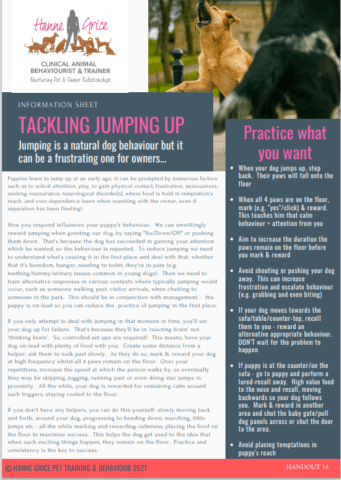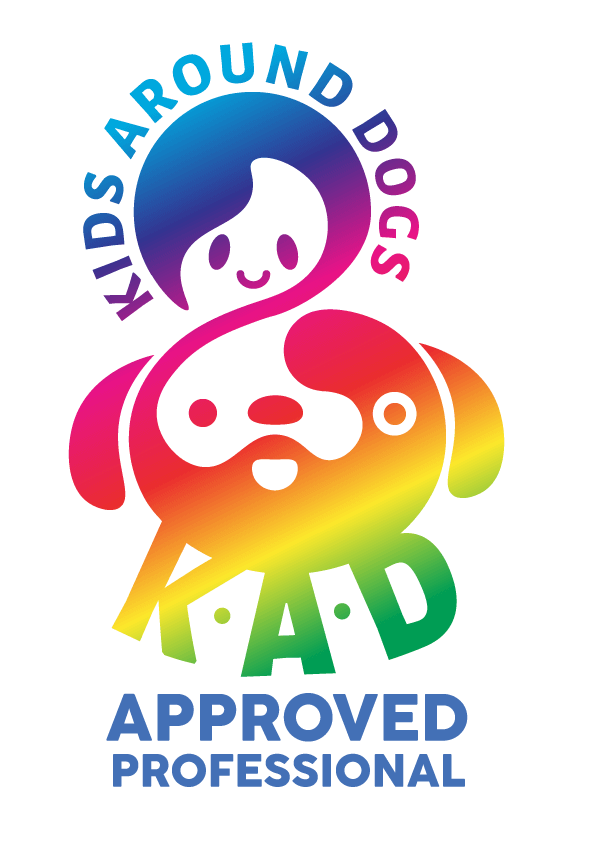One of the most common problems dog owners ask me about at Puppy & Dog School is “How do I stop my dog from jumping up?”
Firstly, jumping forms part of ‘normal’ dog behaviour, typically, produced as part of dog’s greeting ritual. To understand how to tackle jumping, you need to be aware of the common factors that drive jumping behaviour.
Factors that can prompt jumping:
- Performed as part of the greeting
- To solicit attention
- To solicit play
- Incomplete training
- To gain physical contact
- Frustration
- Anxiousness
- Seeking reassurance
- Neurological disorder[s]
- Over-dependence on the owner (often seen upon reuniting, even if separation has been momentary)
However, there is a paucity in scientific data relating to jumping up. A recent study by Rezac et al., (2017) examined the contexts in which jumping occurred and the factors relating to jumping. The researchers found; dogs most frequently jumped up at owners upon entering the home and during walks, guard dogs jumped less on strangers than other dogs, female dogs jumped more on household members and strangers during a walk, dogs walked at least twice a day were more likely to jump on their household members during walks than those walked less often. They also found dogs were more likely to lick the owner’s face when the owner’s crouched than when they stood upright. Rezac et al. concluded familiarity, location, human body posture, the dog’s sex, size, use of the dog and frequency of walks all affected jumping up behaviour.
For ANY behaviour to be repeated – even the stuff you don’t like – there must be reinforcement. That means somehow the dog is getting rewarded for jumping up which is causing it to be repeated. So, being aware of how you handle this is key; otherwise you maybe unwittingly reinforcing jumping up.
For example; when I ask a client how are you currently dealing with the dog’s jumping they may say “I tell him to get down”, “stop”, “say no to the dog” or push him away. Each one of these examples can reinforce jumping.
Why? For a dog that wants interaction, even a telling off is interaction; pushing the dog away when he jumps also creates unintentional reinforcement as obstructing efforts generates persistence, frustration and further separation-distress, not great when you’ve already got an anxious dog!
Think about this…
How often do you ever give your dog feedback when he is quietly resting, especially young dogs? If the dog learns he gets a big reaction for doing something like jumping up, then he will continue to jump even if he is ‘told off’. By contrast, if your dog jumps up and you say nothing but step back so the dog cannot make physical contact with his paws, the dog receives no reinforcement. With absolute consistency, the jumping behaviour will reduce and extinguish altogether because there is no longer any reward for jumping.
So, that brings me onto lack of consistency. This is one of the biggest issues when it comes to problem behaviour. For example; some people may tell their dog off for jumping up but give their pet attention when he places his front paws on the owner’s legs for a ‘fuss’. Often when the kids come home from school they are excited to see their furry friend and say “hi” whilst Fido is leaping about, this may then lead to the dog getting told off by the parent – how confusing is that for the dog! Moreover, such intermittent schedules of reinforcement and punishment can lead to more resilient unwanted behaviour (jumping).
So what can you do about it?
Prevention, management and training:
- Restrict your dog’s access from any areas that jumping occurs. If your dog is crate trained use this or have him on-lead and wearing his harness upon visitor arrivals.
- Teach your dog that for anything he desires such as attention, food, grooming, fuss, putting the lead on, going out etc, this requires all four paws being on the floor. This means he has to have all feet on the ground – he can be in any position, sitting/standing/laying – as long as he is connected to the ground. If he jumps up, step back, wait for the feet to fall to the floor, then wait a beat or two and reward him with calm praise/a stroke/treat – whatever your dog enjoys.
- By mindful of where you are holding food; often poor reinforcer delivery (e.g.) dangling a treat just out of reach, can cause the wanted behaviour (sitting) to breakdown and result in the dog leaping up in an attempt to get the food. Similarly, when interacting with your dog, ensure hands are low – bringing hands over the head to stroke may prompt the dog to shrink back from your hand and or jump up.
- Avoid shouting/using non-reward markers (e.g.) “ah-ah” etc and repeating verbal cues over and over again (e.g., “sit, sit…sit, sit…”) – this can drive frustration which can increase the risk of high arousal behaviour including jumping up.
- Ask friends or family to pop over to help you practice visitor arrivals. You can be as controlled as having your dog in another room on his lead and harness when they arrive, then bring him into the room once the visitor has settled. Bring your dog in on their lead, away from the visitor and over to the bed/mat – have plenty of food with you, and then reward at a high rate on the mat, to encourage your dog to stay with you on the mat in the visitor’s presence. Overtime, the rate of which you reward slows down as your dog learns what to do when visitors are around – stay calm on the mat.
Good luck and happy training.
Reference
Rezac, P., Koru, E., Havlicek, Z., and Pospisilova, D. (2017) ‘Factors affecting dog jumping on people.’ Applied Animal Behaviour Science 197 pp. 40-44
Click here to download our handout.

Learn more about our classes

Get Hanne's Book
Playing With Your Dog will help any dog owner work out the games that are best suited for their pet to play throughout his life, from puppyhood to old age. The book also shares some tricks for all ages, group activities, and recommended toys that dogs will enjoy.

























